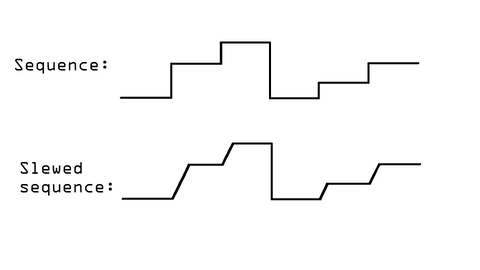Getting Started: Slew
Today, we continue our Getting Started series with a utility that’s incredibly popular in many styles of patching: the slew limiter. Slew limiters have a variety of uses, and today we’ll talk about what they are, how they work in a patch, and a few of the most common uses.
What is slew?
A slew limiter, occasionally referred to as a slew, a lag processor or an integrator, is a utility that changes how quickly voltage changes level. The simplest way to explore what a slew does to a signal is with a gate signal. Unprocessed, a gate signal near-instantaneously goes from 0 volts to 5 volts. However, if we run that signal through a slew, it slowly ramps up to 5 volts, then slowly goes back down to 0 when the gate goes low.

Already, we have a useful patch: we’ve just created an ASR envelope, which I use all the time to control the VCAs of my voices.
Slew limiters vary slightly in the types of controls they have. Some slews are simple and have a single parameter that controls the rise and fall time – that is, how fast the signal changes. Others have independent rise and fall times, and sometimes also have curve controls that change the shape of the slewing:

Some slew limiters can also have their rise and fall times CV controlled: this opens up some interesting possibilities in more complex patches, as in this next example.
Creating portamento with slew
Another common use for pitch-accurate slews is to create portamento in a pitch sequence: by running pitch CV through a slew limiter we can make instantaneous note changes glide from one note to the next. This is a great way to create slides and give a different feeling to a sequence. This is another place where more complex slews can be very useful: for instance, you can set the rise slew time relatively long and the fall time short to create slurs when notes are ascending but not descending, and if you have voltage control over slew times, you can sequence it to slur some notes, but not all.

Of course, this same technique can be used to smooth out any type of CV, whether it’s modulating pitch or another CV destination. For instance, if we’re using a step sequencer to modulate a wavefolder, we can run the CV through a slew to create more gradual changes instead of sudden steps.
Slew features that aren’t slewing
Often, slews have some extra features that make them more versatile. For example, some slews have trigger inputs that allow them to act as a simple attack/decay envelope. Some also have a cycle option that allows them to be used as LFOs. This can make a well-featured slew a versatile utility, especially in a smaller system.
For advanced patchers: Slew all the things!
Slew limiters can be used on any type of signal, even audio. I’ll sometimes run LFOs through slew limiters to get a different-but-related modulation signal: even if a signal is already smooth, you’ll end up with a variation on your original CV. It’s also nice for LFO shapes like saws and ramps, which may have quick transition from peak to minimum.
Slew limiters are also, technically, lowpass filters, so if you need to change up an audio signal in a pinch, slews can come to the rescue!
LOOKING FOR MODULES?
Here are just a few modules that can perform some of the functions we've been chatting about. There are always lots of choices in modular!
Sinc Bucina: A simple slew that also has a built-in VCA/filter for use as a lowpass gate.
Random*Source Dual Universal Slope Generator: A Eurorack adaptation of the influential classic Serge slew, featuring two channels and a comprehensive featureset.
Joranalogue Contour 1: A compact single-channel slew with a wide variety of features.





